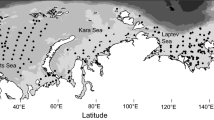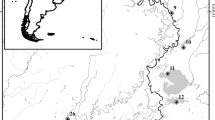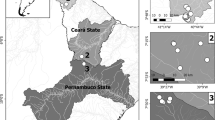Abstract
Benthic algae were collected from central and northern Chinese rivers to test the hypothesis that geographic location has significant contributions in shaping algal assemblages. We used Moran’s eigenvector maps (MEM) to model spatial components and variation partitioning to quantify the influences of spatial and environmental variables on regional patterns of algal richness and community composition, respectively. We found that variation in algal richness was attributed to MEM component 2, 8, and 9 and the quadratic term of N–NO3. Regarding abundance data, latitude, longitude, and MEM component 1, 2, and 7 were important spatial variables. Although P–PO4, pH, and annual mean temperature were significant environmental variables influencing algal community composition, they were all spatially structured. Among the total explained variance in both algal metrics, spatial proportions were higher than that of environmental variables. We also found that abundant species of Achnanthidium minutissimum, Cocconeis placentula, Cymbella delicatula, Cymbella affinis, Cymbella turgidula, and Synedra ulna displayed clear spatially related patterns. In conclusion, the contributions of spatial and environmental variables to regional variation of algal assemblages are scale-dependent. As for our study scale (~1,000 km), spatial control may be more important. Since spatial effects could obscure local environmental impacts on algal communities, appropriate study scale and statistical methods should be taken into account in algal bioassessment. We recommend inclusion of both algal richness and community composition in study of algal biogeography, due to their different relationships with spatial and environmental variables.


Similar content being viewed by others
References
Andersen R, Poulin M, Borcard D, Laiho R, Laine J, Vasander H, Tuittila ET (2011) Environmental control and spatial structures in peatland vegetation. J Veg Sci 22:878–890
Baas-Becking LGM (1934) Geobiologie of inleiding tot de milieukunde. W.P. Van Stockum & Zoon, The Hague (in Dutch)
Besse-Lototskaya A, Verdonschot PFM, Coste M, Van de Vijver B (2011) Evaluation of European diatom trophic indices. Ecol Indic 11:456–467
Biggs BJF, Smith RA (2002) Taxonomic richness of stream benthic algae: effects of flood disturbance and nutrients. Limnol Oceanogr 47:1175–1186
Blanchet FG, Legendre P, Borcard D (2008) Forward selection of explanatory variables. Ecology 89:2623–2632
Borcard D, Legendre P (2002) All-scale spatial analysis of ecological data by means of principal coordinates of neighbour matrices. Ecol Model 153:51–68
Borcard D, Legendre P, Drapeau P (1992) Partialling out the spatial component of ecological variation. Ecology 73:1045–1055
Borcard D, Legendre P, Avois-Jacquet C, Tuomisto H (2004) Dissecting the spatial structure of ecological data at multiple scales. Ecology 85:1826–1832
Borcard D, Gillet F, Legendre P (2011) Numerical Ecology with R. Springer Science + Business Media, New York
Chen J, Xia X (1999) Progress in research on river hydro-chemistry in china. Sci Geogr Sin 19:290–294 (in Chinese)
Chinese NEPA (2002) Water and Wastewater Monitoring Methods, 4th edn. Chinese Environmental Science Publishing House, Beijing
Cottenie K (2005) Integrating environmental and spatial processes in ecological community dynamics. Ecol Lett 8:1175–1182
Dainese M, Poldini L (2012) Plant and animal diversity in a region of the Southern Alps: the role of environmental and spatial processes. Landsc Ecol 27:1–15
Danielson TJ, Loftin CS, Tsomides L, DiFranco JL, Connors B (2011) Algal bioassessment metrics for wadeable streams and rivers of Maine, USA. J N Am Benthol Soc 30:1033–1048
Dray S, Legendre P, Peres-Neto PR (2006) Spatial modelling: a comprehensive framework for principal coordinate analysis of neighbour matrices (PCNM). Ecol Model 196:483–493
Duong TT, Coste M, Feurtet-Mazel A, Dang DK, Gold C, Park YS, Boudou A (2006) Impact of urban pollution from the Hanoi area on benthic diatom communities collected from the Red, Nhue and Tolich rivers (Vietnam). Hydrobiologia 563:201–216
Finlay BJ (2002) Global dispersal of free-living microbial eukaryote species. Science 296:1061–1063
Gilbert B, Bennett JR (2010) Partitioning variation in ecological communities: do the numbers add up? J Appl Ecol 47:1071–1082
Gotelli NJ, Colwell RK (2001) Quantifying biodiversity: procedures and pitfalls in the measurement and comparison of species richness. Ecol Lett 4:379–391
Hanski I (1999) Metapopulation Ecology. Oxford University Press, Oxford
Heino J (2011) A macroecological perspective of diversity patterns in the freshwater realm. Freshwat Biol 56:1703–1722
Heino J (2013) The importance of metacommunity ecology for environmental assessment research in the freshwater realm. Biol Rev 88:166–178
Heino J, Soininen J (2006) Regional occupancy in unicellular eukaryotes: a reflection of niche breadth, habitat availability or size-related dispersal capacity? Freshwat Biol 51:672–685
Heino J, Soininen J (2007) Are higher taxa adequate surrogates for species-level assemblage patterns and species richness in stream organisms? Biol Conserv 137:78–89
Heino J, Bini LM, Karjalainen SM, Mykrä H, Soininen J, Vieira LCG, Diniz-Filho JAF (2010) Geographical patterns of micro-organismal community structure: are diatoms ubiquitously distributed across boreal streams? Oikos 119:129–137
Heino J, Grönroos M, Soininen J, Virtanen R, Muotka T (2012) Context dependency and metacommunity structuring in boreal headwater streams. Oikos 121:537–544
Holyoak M, Leibold MA, Mouquet N, Holt RD, Hoopes M (2005) A framework for large scale community ecology. In: Holyoak M et al (eds) Metacommunities: spatial dynamics and ecological communities. The University of Chicago Press, Chicago, pp 1–31
Hu H, Wei Y (2006) The Freshwater Algae of China: Systematics. Science Press, Beijing (in Chinese), Taxonomy and Ecology
Jao C (1988) Flora Algarum Sinigrum Aquae Dulcis (Tomus I): Zygnemataceae. Science Press, Beijing (in Chinese)
Kociolek J, Spaulding S (2000) Freshwater diatom biogeography. Nova Hedwigia 71:223–242
Kristiansen J (1996) Dispersal of freshwater algae—a review. Hydrobiologia 336:151–157
Legendre P (2008) Studying beta diversity: ecological variation partitioning by multiple regression and canonical analysis. J of Plant Ecol 1:3–8
Legendre P, Gallagher ED (2001) Ecologically meaningful transformations for ordination of species data. Oecologia 129:271–280
Leh C, Wang T (1963) Chemical characteristics of Chinese rivers. Acta Geogr Sin 29:1–13 (in Chinese)
Leibold M, Holyoak M, Mouquet N, Amarasekare P, Chase J, Hoopes M, Holt R, Shurin J, Law R, Tilman D (2004) The metacommunity concept: a framework for multi-scale community ecology. Ecol Lett 7:601–613
Leira M, Sabater S (2005) Diatom assemblages distribution in catalan rivers, NE Spain, in relation to chemical and physiographical factors. Water Res 39:73–82
Lepš J, Šmilauer P (2003) Multivariate Analysis of Ecological Data Using CANOCO. Cambridge University Press, Cambridge
Li S, Bi L (1998) Flora Algarum Sinicarum Aquae Dulcis (Tomus V): Ulothricales Ulvales Chaetophorales Trentepohliales Sphaeropleales. Science Press, Beijing (in Chinese)
Logue JB, Mouquet N, Peter H, Hillebrand H (2011) Empirical approaches to metacommunities: a review and comparison with theory. Trends Ecol Evol 26:482–491
Martiny JBH, Bohannan BJM, Brown JH, Colwell RK, Fuhrman JA, Green JL, Horner-Devine MC, Kane M, Krumins JA, Kuske CR (2006) Microbial biogeography: putting microorganisms on the map. Nat Rev Microbiol 4:102–112
Mezger D, Pfeiffer M (2011) Partitioning the impact of abiotic factors and spatial patterns on species richness and community structure of ground ant assemblages in four Bornean rainforests. Ecography 34:39–48
Ng IS, Carr CM, Cottenie K (2009) Hierarchical zooplankton metacommunities: distinguishing between high and limiting dispersal mechanisms. Hydrobiologia 619:133–143
Passy SI (2007) Community analysis in stream biomonitoring: what we measure and what we don’t. Environ Monit Assess 127:409–417
Passy SI (2010) A distinct latitudinal gradient of diatom diversity is linked to resource supply. Ecology 91:36–41
Passy SI, Blanchet FG (2007) Algal communities in human-impacted stream ecosystems suffer beta-diversity decline. Divers Distrib 13:670–679
Patrick R, Reimer CW (1966) The Diatoms of the United States, exclusive of Alaska and Hawaii. Monograph No. 13. Academy of Natural Sciences, Philadelphia
Patrick R, Reimer CW (1975) The Diatoms of the United States. Vol. 2, Part 1. Monograph No. 13. Academy of Natural Sciences, Philadelphia
Peres-Neto PR, Legendre P, Dray S, Borcard D (2006) Variation partitioning of species data matrices: estimation and comparison of fractions. Ecology 87:2614–2625
Peterson CG, Grimm NB (1992) Temporal variation in enrichment effects during periphyton succession in a nitrogen-limited desert stream ecosystem. J N Am Benthol Soc 11:20–36
Pringle CM (1990) Nutrient spatial heterogeneity: effects on community structure, physiognomy, and diversity of stream Algae. Ecology 71:905–920
Qi Y (1995) Flora Algarum Sinicarum Aquae Dulcis (Tomus IV): Bacillariophyta Centreae. Science Press, Beijing (in Chinese)
Quinn GP, Keough MJ (2002) Experimental Design and Data Analysis for Biologists. Cambridge University Press, Cambridge
Rimet F (2012) Recent views on river pollution and diatoms. Hydrobiologia 683:1–24
Sattler T, Borcard D, Arlettaz R, Bontadina F, Legendre P, Obrist M, Moretti M (2010) Spider, bee, and bird communities in cities are shaped by environmental control and high stochasticity. Ecology 91:3343–3353
Schuldt A, Assmann T (2009) Environmental and historical effects on richness and endemism patterns of carabid beetles in the western Palaearctic. Ecography 32:705–714
Sharma NK, Rai AK (2010) Biodiversity and biogeography of microalgae: progress and pitfalls. Environ Rev 19:1–15
Sharma S, Legendre P, De Cáceres M, Boisclair D (2011) The role of environmental and spatial processes in structuring native and non-native fish communities across thousands of lakes. Ecography 34:762–771
Shi Z (2004) Flora Algarum Sinicarum Aquae Dulcis (Tomus XII): Bacillariophyta Gomphonemacea. Science Press, Beijing (in Chinese)
Smith TW, Lundholm JT (2010) Variation partitioning as a tool to distinguish between niche and neutral processes. Ecography 33:648–655
Soininen J (2007) Environmental and spatial control of freshwater diatoms—a review. Diatom Res 22:473–490
Soininen J (2012) Macroecology of unicellular organisms—patterns and processes. Env Microbiol Rep 4:10–22
Soininen J, Paavola R, Muotka T (2004) Benthic diatom communities in boreal streams: community structure in relation to environmental and spatial gradients. Ecography 27:330–342
Soininen J, Paavola R, Kwandrans J, Muotka T (2009) Diatoms: unicellular surrogates for macroalgal community structure in streams? Biodivers Conserv 18:79–89
Stevenson R, Pan Y, van Dam H (2010) Assessing environmental conditions in rivers and streams with diatoms. In: Smol JP, Stoermer EF (eds) The diatoms: applications for the environmental and earth sciences, 2nd edn. Cambridge University Press, Cambridge, pp 57–85
Stomp M, Huisman J, Mittelbach GG, Litchman E, Klausmeier CA (2011) Large-scale biodiversity patterns in freshwater phytoplankton. Ecology 92:2096–2107
Tang T, Qu X, Li D, Liu R, Xie Z, Cai Q (2004) Benthic algae of the Xiangxi River China. J Freshwat Ecol 19:597–604
Tang T, Niu S, Dudgeon D (2013) Responses of epibenthic algal assemblages to water abstraction in Hong Kong streams. Hydrobiologia 703:225–237
Ulrich W, Zalewski M (2006) Abundance and co-occurrence patterns of core and satellite species of ground beetles on small lake islands. Oikos 114:338–348
Vanormelingen P, Cottenie K, Michels E, Muylaert K, Vyverman WIM, De Meester LUC (2008a) The relative importance of dispersal and local processes in structuring phytoplankton communities in a set of highly interconnected ponds. Freshwat Biol 53:2170–2183
Vanormelingen P, Verleyen E, Vyverman W (2008b) The diversity and distribution of diatoms: from cosmopolitanism to narrow endemism. Biodivers Conserv 17:393–405
Virtanen L, Soininen J (2012) The roles of environment and space in shaping stream diatom communities. Eur J Phycol 47:160–168
Wu C (2001) Changes of river system and new tectonic movement in north China mountainous area. N China Earthq Sci 19:1–6 (in Chinese)
Wu C, Zhang X, Zhao Y (2000) Stratiform geomorphology and Himalayan tectonic movement on the north China mountains. Geogr Terr Res 16:82–86 (in Chinese)
Wu N, Cai Q, Tang T, Qu X (2007) Benthic algae of the Gangqu River, Shangrila, China. J Freshwat Ecol 22:151–153
Zhao J (1995) Physical Geography of China, 3rd edn. Advanced Education Press, Beijing (in Chinese)
Zhu H (2007) Flora Algarum Sinicarum Aquae Dulcis (Tomus IX): Cyanophyta Hormogonophyceae. Science Press, Beijing (in Chinese)
Acknowledgements
This research was financially supported by Major Science and Technology Program for Water Pollution Control and Treatment (No. 2012ZX07104-002; No. 2012ZX07501-002-07) and National Natural Science Foundation of China (No. 30330140). We thank Xiaoli Tong for help in fieldwork, Ruiqiu Liu and Xinghuan Jia for assistance in chemical analysis. Special thanks to Bill Gould for language improvement and valuable comments.
Author information
Authors and Affiliations
Corresponding author
Additional information
Handling Editor: Piet Spaak
Appendix
Appendix
Rights and permissions
About this article
Cite this article
Tang, T., Wu, N., Li, F. et al. Disentangling the roles of spatial and environmental variables in shaping benthic algal assemblages in rivers of central and northern China. Aquat Ecol 47, 453–466 (2013). https://doi.org/10.1007/s10452-013-9458-8
Received:
Accepted:
Published:
Issue Date:
DOI: https://doi.org/10.1007/s10452-013-9458-8




